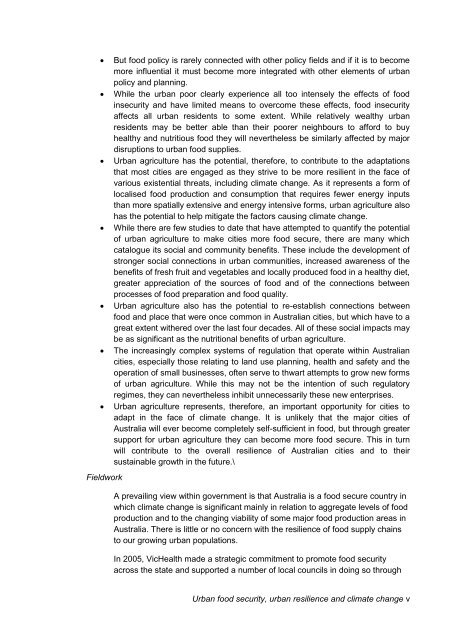Urban food security, urban resilience and climate change - weADAPT
Urban food security, urban resilience and climate change - weADAPT
Urban food security, urban resilience and climate change - weADAPT
Create successful ePaper yourself
Turn your PDF publications into a flip-book with our unique Google optimized e-Paper software.
FieldworkBut <strong>food</strong> policy is rarely connected with other policy fields <strong>and</strong> if it is to becomemore influential it must become more integrated with other elements of <strong>urban</strong>policy <strong>and</strong> planning.While the <strong>urban</strong> poor clearly experience all too intensely the effects of <strong>food</strong>in<strong>security</strong> <strong>and</strong> have limited means to overcome these effects, <strong>food</strong> in<strong>security</strong>affects all <strong>urban</strong> residents to some extent. While relatively wealthy <strong>urban</strong>residents may be better able than their poorer neighbours to afford to buyhealthy <strong>and</strong> nutritious <strong>food</strong> they will nevertheless be similarly affected by majordisruptions to <strong>urban</strong> <strong>food</strong> supplies.<strong>Urban</strong> agriculture has the potential, therefore, to contribute to the adaptationsthat most cities are engaged as they strive to be more resilient in the face ofvarious existential threats, including <strong>climate</strong> <strong>change</strong>. As it represents a form oflocalised <strong>food</strong> production <strong>and</strong> consumption that requires fewer energy inputsthan more spatially extensive <strong>and</strong> energy intensive forms, <strong>urban</strong> agriculture alsohas the potential to help mitigate the factors causing <strong>climate</strong> <strong>change</strong>.While there are few studies to date that have attempted to quantify the potentialof <strong>urban</strong> agriculture to make cities more <strong>food</strong> secure, there are many whichcatalogue its social <strong>and</strong> community benefits. These include the development ofstronger social connections in <strong>urban</strong> communities, increased awareness of thebenefits of fresh fruit <strong>and</strong> vegetables <strong>and</strong> locally produced <strong>food</strong> in a healthy diet,greater appreciation of the sources of <strong>food</strong> <strong>and</strong> of the connections betweenprocesses of <strong>food</strong> preparation <strong>and</strong> <strong>food</strong> quality.<strong>Urban</strong> agriculture also has the potential to re-establish connections between<strong>food</strong> <strong>and</strong> place that were once common in Australian cities, but which have to agreat extent withered over the last four decades. All of these social impacts maybe as significant as the nutritional benefits of <strong>urban</strong> agriculture.The increasingly complex systems of regulation that operate within Australiancities, especially those relating to l<strong>and</strong> use planning, health <strong>and</strong> safety <strong>and</strong> theoperation of small businesses, often serve to thwart attempts to grow new formsof <strong>urban</strong> agriculture. While this may not be the intention of such regulatoryregimes, they can nevertheless inhibit unnecessarily these new enterprises.<strong>Urban</strong> agriculture represents, therefore, an important opportunity for cities toadapt in the face of <strong>climate</strong> <strong>change</strong>. It is unlikely that the major cities ofAustralia will ever become completely self-sufficient in <strong>food</strong>, but through greatersupport for <strong>urban</strong> agriculture they can become more <strong>food</strong> secure. This in turnwill contribute to the overall <strong>resilience</strong> of Australian cities <strong>and</strong> to theirsustainable growth in the future.\A prevailing view within government is that Australia is a <strong>food</strong> secure country inwhich <strong>climate</strong> <strong>change</strong> is significant mainly in relation to aggregate levels of <strong>food</strong>production <strong>and</strong> to the changing viability of some major <strong>food</strong> production areas inAustralia. There is little or no concern with the <strong>resilience</strong> of <strong>food</strong> supply chainsto our growing <strong>urban</strong> populations.In 2005, VicHealth made a strategic commitment to promote <strong>food</strong> <strong>security</strong>across the state <strong>and</strong> supported a number of local councils in doing so through<strong>Urban</strong> <strong>food</strong> <strong>security</strong>, <strong>urban</strong> <strong>resilience</strong> <strong>and</strong> <strong>climate</strong> <strong>change</strong> v
















